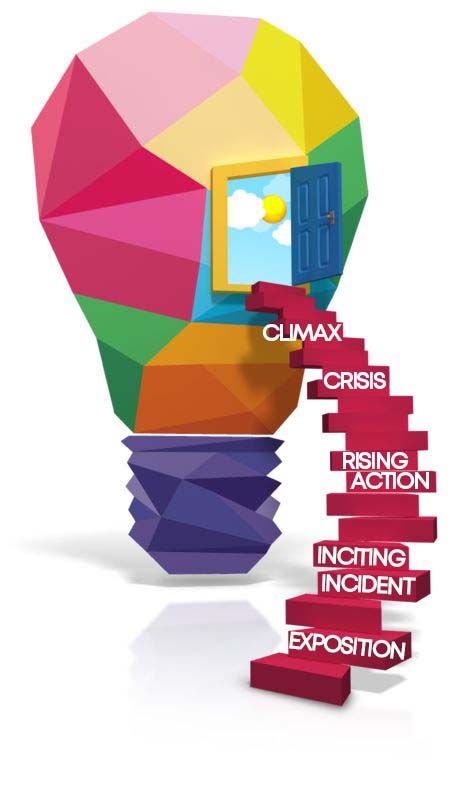Not everyone dares to write. It may seem easy, as you only need to have a pen and paper to do it, but there are underlying complexities that you need to consider. Especially if you are writing a story because there are some existing factors that you need to be very clear about, and one of them is the plot.
In order to get the most out of this document (mini-course), there are a few terms you should be clear on:
Narrative
The telling of a story; a written or spoken account of related events
Setting
The time and place in which a story takes place. Some examples of settings are:
— The frozen tundra in present day
— a ship sailing the high seas in the early 1900s.
Plot
In the literary sense, a plot is the order of main events that tells the story in a certain way. We see plots unfolding all around us in books, television shows, films, songs and other creative arts.
Many books, movies, plays, TV shows… are boring, for good reason. Their plots are not being used to their fullest, if at all. Overall, the importance of a plot in a story is vitally important to understand.
To write a memoir, historical fiction or any kind of story, knowing how to use “the plot” effectively is the key to having a book that is a page turner. Therefore, here are the “must-do’s" for generating killer plots:
1. Conduct Your Plot Research

Plot writing is a battle you need to prepare for. You do this by researching the subject or topic. You have to be equipped with knowledge and understanding about what you are writing about.
Betty White once said this about plot, which shows that we need to be at our A-game when working the plot:
“The audience today has heard every joke. They know every plot. They know where you're going before you even start. That's a tough audience to surprise, and a tough audience to write for. It's much more competitive now, because the audience is so much more — I want to say ‘sophisticated." —Betty White
One way of the quickest ways to gain knowledge is to recognize the plot techniques of other stories already in existence. That’s right, there is a lot of technique involved.
You don’t just tell the story as it happened or incident by incident so much as being alert to how events will impact your readers. When do you want things to move quickly? When should they slow down and give readers a break? Where should the intensity go? Should there be any comic relief?
Noticing the plots of some of your favorite writers or from writers you wish to emulate is especially helpful if you are new to the area of writing compelling stories.
The plot gives character, uniqueness, personality, twists and turns, ups and downs… to your story. It could be compared to a roller-coaster ride.

Which story do you think readers would want to read:
- A linear, predictable, uneventful story?
- An unpredictable wild roller-coaster ride?
Find examples of the type of writers or writing styles you like and consider these things:
- How was the plot structured?
- How did the plot affect the characters?
- Did the plot compliment the settings?
Take note of whether you like how the author played out their plot or whether you see a better or different way to write yours. This will help you to come up with your own plot with regard to these 3 aspects.
Of course, if you’re a newbie, you may not yet trust your judgement of whether someone’s plot is good or bad. The truth is, you definitely have the capacity already to judge or conclude such things simply because much of it is based on personal preference. But just don’t every forget that you are writing for an audience, and you should keep them in mind. In other words, what would they potentially enjoy, like or appreciate? THAT is a valuable question that can make you a very successful author.
No doubt, it is always a good idea to learn from the best. If you’re not sure where to start, here are some books that have excellent plot structures. Learn from them and then develop your own ideas for your plot:
- Sharp Objects by Gillian Flynn,
- Identical by Ellen Hopkins,
- We Were Liars by E. Lockhart,
- Salem Falls by Jodi Picoult
- Beautiful You by Chuck Palahnuik.
2. Start With Your Plot Framework
Now that you have some idea of story plots that have been well-received by these authors’ audiences, start conceptualizing the backbone of your plot. Jot down your main ideas in a brainstorm-like fashion, and then massage them and build on them based on what feels right.

Develop an appropriate plotting process that will mold and shape your plot that works best for you. You will come to find your ideal process, but to give you a starting point, think of the elements you want in your story: highs and lows, fast and slow paces, any comical areas, anyplace you want your readers to feel pain or sadness, and the twists and turns (surprises your readers wouldn’t expect)… things that keep your story moving and changing.
Having a framework for your plot will have a good domino effect on your story.
Once you have the different aspects for your story’s plot, you can begin to think of how each of them could be created. For instance, certain incidents that would bring out the different effects. To create tension, for instance, you might use what a character is experiencing internally while being chased by a paid killer. Internally in the sense of how his mouth is so dry, he couldn’t swallow. Her heart was pounding in her chest as she gasped for air…, whatever would cause your readers to experience, think or feel that you want them to.
After having the main parts or framework of your plot, you can start adding more elements that would connect the main parts of your story.
3. Rely on Freytag's Pyramid

Gustav Freytag, a German novelist changed Aristotle's concept of a plot by adding more factors. Originally, there were 3 concepts, but now it includes these:
- Exposition (Prologue): Exposition can be defined as “exposing” or revealing the specific background or supporting information of a story. It serves as an introduction, which sets up the aspects of the story by revealing the basics of the plot in many ways, such as: the main character backgrounds/backstories, setting, prior events that affect the story historical information, and more.
- Inciting Incident: This part is the starting point that revolves around the story. Usually, it occurs when a character meets a circumstance where he or she must settle. It goes against what s/he believes in and must seek to change for the better (based on their reality). Even an insane character believes they are doing good, no matter how destructive.
- Rising Action: Dubbed as the pre-conflict, the rising action is where the protagonist tries to resolve the problem, but it gets more complicated with certain turns of events, that build upon each other, resulting in greater and greater intensity. This makes the next concept possible.
- Climax: This is the part where thrill and excitement are well-developed. The protagonist and antagonist would clash because of the conflicts with which the two parties have with one another.
- Falling Action: After the jam-packed climax, the falling action takes place as a result. This usually involves the impact of the climax to the protagonist and how it changed him/her.
- Resolution: The protagonist finally solves the conflict in some way. This can even be that s/he gives in to the fact that what they were fighting could not be stopped. But take caution with such a result because people seek resolve in books and movies, not doom and gloom. They want to see the hero or heroin win in the end and justice prevail.
- Denouement (Epilogue): This wraps up the entire story based on how the conflict was resolved, or summates things in order to raise questions or conclusions.
4. Know Your 6Ws
The staple of every literary piece, whether fiction or nonfiction, is the 6Ws—what, who, where, when, how and why.

WHAT
The first W in the 6Ws is WHAT. What does ''what'' define in your story? It causes you to tackle the story itself. It askls "what happens?" This is the most crucial question in the 6Ws as it will define the others.
WHO
WHO means the persons or characters involved in the story. They are the catalysts that cause things to happen in the story, thus it is essential to have an in-depth understanding of how they would be placed in the plot and their roles.
WHERE
The setting of the story is what ''WHERE'' defines. Will it be in a quaint Victorian rural town? Or in a modern, bustling urbanized city? Or maybe it’s on a strange, distant planet. Whatever you decide it will be, it is another important question to answer.
WHEN
Apart from the person and setting, ''WHEN'' is also an important aspect in a plot. Decide whether you want your story to be set in the old era, new era, the future, or multiple eras.
HOW
HOW allows you to describe the way in which things will happen in your story. When you want something to occur, HOW gives you the opportunity to explain the things that have to happen for such a result.
WHY
WHY may be last on the list, but it is the most important of all. Justifying why your story exists gives purpose. It serves as the center or driving force of the story, making it the most important question to answer.
Overall, the 6Ws must complement each other to come up with a harmonious and “killer” story plot.
5. Understand Your Target Market

You are writing a story plot for others to enjoy. Whether you will or will not write for business purposes, understanding the needs and wants of your chosen audience is an important step for your plot.
When you are plotting your story, put yourself into their shoes and ask yourself a few questions that audiences would consider in a plot. What do you expect in the story? What factors of a plot would look enticing? You will surprise yourself with what you will discover in that experience.
6. Play With Your Conflicts
We all know that everybody loves conflict! The thought of clashing arguments against two parties gives people adrenaline and makes them crave for more. But there’s more to it than meets the eye. Without conflict, a story would be boring. There would be no one to root for or to hate. There would be nothing to challenge the protagonist. The story would be too slow moving and purposeless almost to the point of monotony.
Many authors do not have this understanding, and they miss out on what would have been a great story if they truly knew more about developing the plot.
So, it is extremely important you realize that one of the elements a killer story plot must have is the ability to get a rise out of your audience and get them personally involved, taking a side, being anticipated of outcomes… by playing with conflicts.
Venture into the world of conflicts. Here are the 5 main conflict scenarios. Notice, it is one against another:
- Man vs. Self: A form of internal conflict that the protagonist usually feels especially if there are hefty emotions involved.
- Man vs. Man: This the most common yet famous external conflict in this list. This is mostly found in stories with heavy genres.
- Man vs. Society: This usually occurs externally between the environment or culture. This conflict is heavily affiliated with tradition or norms.
- Man vs. Nature: An uncommon type of conflict where a person is battling against the force of nature. One of the most famous stories that emphasize this conflict is Daniel Defoe's, Robinson Crusoe, where he defied the power of the raging sea.
- Man vs. Supernatural: This conflict exists when there are supernatural beings involved, such as gods and goddesses. One great example of a story with a man vs. supernatural conflict is the infamous Greek and Roman Mythology.
With these and more, you can mix and match conflicts that you can incorporate into your plot. Do not limit yourself with one. And understand that the protagonist (“Man” in the list above) does not have to be human
7. Incorporate Subplots

Make your plot more interesting by including subplots into your main plot. Even the stories from Disney have hidden treasures to support their plots and make their stories more interesting.
Along with your story's main plot and character development, integrate the subplot unusually. You can do it by having more characters that viewers would view as side characters where, in fact, they secretly hold the key to the resolution. As a result, you can have a smooth transition from subplots to the twist.
NOTE: Remember, everything in your story needs to have good reason to be included. You don’t add side characters or a subplot just to have a side story. It has to tie in, in some way. Otherwise, it is senseless.
8. Surprise Your Audience With Twists!
Clichés are often the downfall of a story as the audience would highly predict what would happen next. So, to have a great impact on your audience, you need to let them get pulled into the usual and hit them with an unexpected twist.
To make this work, you need to build up your story. Orient your audience with subtle hints about the hints (what might happen). With the development, avoid underwhelming or dramatic twists. It must be enough to give your audience a shock factor while remaining believable.
9. Not All Endings Are Happy
Sometimes, breaking norms is the best decision that you will make. Especially for stories, not all endings are happy. Couples do not always end together. Not all of the characters can survive, even the protagonist.
In fact, taking the other route would create a more realistic approach to your story that would make it more appealing to some people. One great example of this is Ian McEwan's award-winning masterpiece, Atonement where the protagonist creates an imaginary happy ending out of the tragic one.

But never forget, you cannot get away with doing this often. Readers will stop following you if you keep disappointing them with sad endings. There is enough hardship in life, and one of the reasons people read is to escape from the harsh reality of the real world.
Remember, killing characters out of nowhere is not exciting at all. Readers would feel betrayed as their feelings have been toyed with. Give them the satisfaction by having great closure of the characters.
10. Ask for Feedback
What other ways would you be able to develop an effective killer plot? By gathering feedback from your test audience! Having the opportunity to pick the brains of your reader's mind is priceless. What better way is there than to get it straight from the horses mouth, as the saying goes.
Gather some reliable and trustworthy beta readers who would give you feedback. Get them involved. Allow them to provide you with their observations as to how your story would be better.
You can even test your twists! First, ask them as to what their expectations are, and jot them down. Then, make them read the story and discern their raw reactions from it.
However, do not tell them beforehand. Let them enjoy the story naturally. You don’t want to lead them on. Your best feedback will be without guidance or suggestion. Otherwise, you will get skewed data and ruin the purpose of having beta readers in the first place.
Now that you reached this far, you are now ready to make a killer and jaw dropping story!
Become Masterful at Story Plots!
The document you just read is an advanced OVERVIEW to MORE DETAILED TRAINING MATERIAL you can access right now to gain greater understanding of the many elements and aspects to creating an amazing plot.
Without question, if your plot is weak, your story will be weak as well.
Log in and get this little-known information. With our unprecedented Quick-Start Training (QST) approach to learning, we make learning quick and simple so you can get back to what you love doing most.
Not a member of Author Utopia? Today's a good day to join!
Just click the SIGN UP NOW button above and you will be taken to our secure registration page where you can sign up and get this, and ALL of our training information for FREE!
Here is Your Next Step in Plot Creation...
Your Quick-Start Training continues here: https://www.authorutopia.com/the-key-elements-to-writing-a-compelling-chapter/
You're on your way to becoming a master plot maker!


